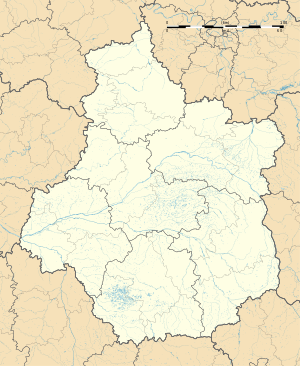Épernon
| Épernon | ||
|---|---|---|
| Commune | ||
 View from the prairie | ||
| ||
 Épernon Location within Centre-Val de Loire region  Épernon | ||
| Coordinates: 48°36′41″N 1°40′30″E / 48.6114°N 1.675°ECoordinates: 48°36′41″N 1°40′30″E / 48.6114°N 1.675°E | ||
| Country | France | |
| Region | Centre-Val de Loire | |
| Department | Eure-et-Loir | |
| Arrondissement | Chartres | |
| Canton | Épernon | |
| Intercommunality | Val Drouette | |
| Government | ||
| • Mayor (2008–2014) | Françoise Ramond | |
| Area1 | 6.43 km2 (2.48 sq mi) | |
| Population (2008)2 | 5,254 | |
| • Density | 820/km2 (2,100/sq mi) | |
| Time zone | UTC+1 (CET) | |
| • Summer (DST) | UTC+2 (CEST) | |
| INSEE/Postal code | 28140 /28230 | |
| Elevation | 110–165 m (361–541 ft) | |
|
1 French Land Register data, which excludes lakes, ponds, glaciers > 1 km2 (0.386 sq mi or 247 acres) and river estuaries. 2 Population without double counting: residents of multiple communes (e.g., students and military personnel) only counted once. | ||
Épernon is a commune in the Eure-et-Loir department in the Centre-Val de Loire region in northern France. It lies some 27 kilometres (17 miles) northeast of Chartres, at the confluence of the Drouette and the Guesle.
History
Épernon was originally the home of the counts of Montfort and Amaury. In the 11th century, they raised the fortresses of Épernon and Montfort for the protection of the Château de St Léger and granted a charter to the town. Four gates gave access to the medieval city: the gate of Chartres, the gate of Geolle, the gate of Paris and the gate of Beauce. Above the gates an inscription paid homage to the village that previously existed there: Autrist fut jadis mon nom/A présent on me nomme Espierremont (Autrist was once my name/now my name is Espierremont). Charters of the 12th and 13th century variously refer to the town as Sparno and Sparnonum, but by the 14th century it had evolved to Esparnon and Espernon, very close to its present appellation.
In the 13th century it became an independent lordship, which remained attached to the crown of Navarre till, in the 16th century, it was sold by Henry III of France to Jean Louis de Nogaret de La Valette, for whom it was raised to the rank of a duchy in 1581. De Nogaret's second son, Bernard (1592–1661), succeeded his father to the dukedom and after his death, the title was borne by the families of Goth and of Pardaillan.
The Marquis de Sade was buried in an unmarked grave on his family property in Épernon.
Épernon today
Although the Montforts were an important family and Épernon was an important duchy up through the 17th century, its location on the fringes of its greater neighbors of Chartres, Nantes and others left it somewhat passed over for a time. The population in 1999 was 5,498 but it is enjoying something of a resurgence as a fast-growing high-tech industrial center (2800 of 3400 jobs are in the industrial sector).
Education
The town is endowed of one secondary school named after the French mathematician Michel Chasles and which was founded in 1973. It is located on the Boulevard Michel Chasles and is composed of three buildings (A, B and C).
Population
| Historical population | ||
|---|---|---|
| Year | Pop. | ±% |
| 1962 | 2,417 | — |
| 1968 | 3,329 | +37.7% |
| 1975 | 4,200 | +26.2% |
| 1982 | 4,950 | +17.9% |
| 1990 | 5,097 | +3.0% |
| 1999 | 5,498 | +7.9% |
| 2008 | 5,254 | −4.4% |
See also
References
External links
| Wikimedia Commons has media related to Épernon. |
- Épernon official website
- French Ministry of Culture list for Épernon
- Collège Michel Chasles official website
